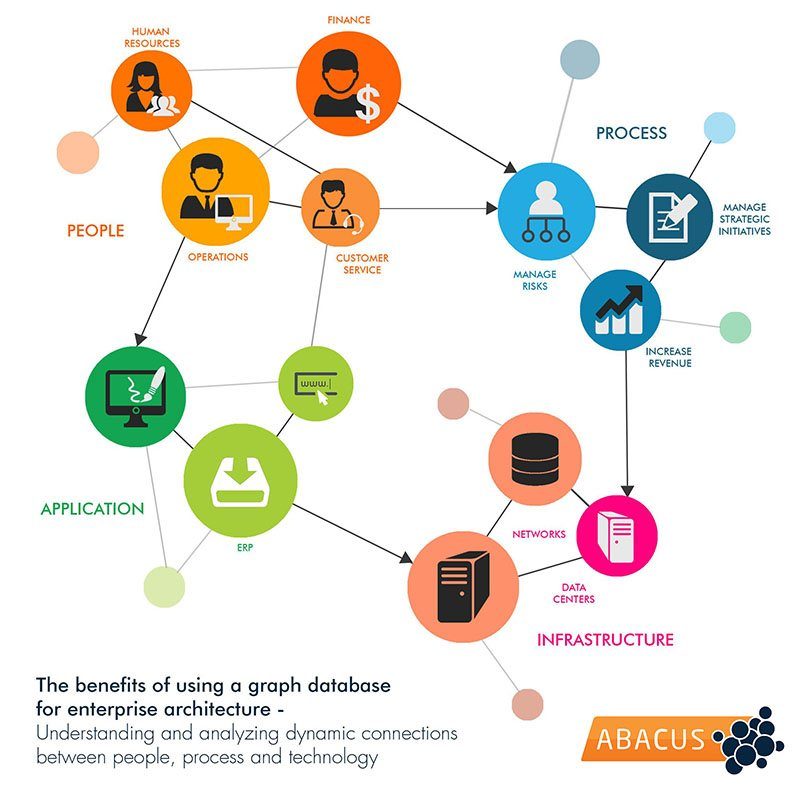The ABACUS enterprise architecture tool has used graph database technology for over 20 years. We believe that graph databases offer the adaptability that enterprise architects need to manage changing business conditions and large data volumes.
Graph databases also offer ease-of-use day-to-day and future-proof an enterprise architecture program, allowing EAs to adapt and update data structures and frameworks.
Other EA tool vendors have traditionally used relational databases, but as the demands of users increase and new analysis techniques emerge the restrictions of relational databases are becoming a source of frustration for many organizations.
What is a graph database?
Graph databases are ideal for capturing and navigating complex data and relationships. They are used for social networks, recommendation engines, fraud detection, inventory management and many other modern systems.
Rather than using rigid tables to collect and structure information, a graph database structures data as objects with direct relationships to other objects. This provides flexibility in structuring data. It also prevents your application from having to continually scan for individual objects in massive tables – and that means big increases in speed.
Graph databases are based on graph theory. Objects are known as nodes and relationships to other objects are known as edges. Any of the nodes or edges captured in a graph database can have a list of properties which are unique.
What advantages can enterprise architects gain from graph databases (“enterprise graphs”) ?
As a report on Graph databases by an independent analyst states: “Graph databases can store and process large volumes of data and enable the search, discovery, and exploration of large networks.
“To support the demands of the digital business, enterprise architects must consider how best to link large volumes of complex, siloed data. Linking a few data sources is often simple, but to do so with significant amounts of heterogeneous data requires a radically new approach.
“Graph databases are a powerful optimized technology that link billions of pieces of connected data to help create new sources of value for customers and increase operational agility for customer service.”
The value in Enterprise Architecture comes not from understanding details of entities in isolation, but from understanding the relationships between those entities and the rest of the enterprise.
This allows EAs to grasp the impact that changing one entity will have across an entire organization.
Graph databases can capture these real-world relationships accurately.
The value in Enterprise Architecture comes not from understanding details of entities in isolation, but from understanding the relationships between those entities and the rest of the enterprise. The power of graph databases comes from the ability to analyze and manipulate these links in a way that would simply take too long with data stored in a relational format.
Who uses graph databases?
Google, eBay, Amazon, Walmart, Yahoo!, JP Morgan Chase, NASA, Adobe, Cisco, Raytheon, Siemens, Ford, Pfizer, to name a few.
Leading retailers use graph databases to better understand customers and buying habits, stock brokers use them to understand market trends. They are used in social networks and many other applications.
How will using a graph database make my work as an EA easier?
For enterprise architects the day-to-day advantage of a graph database back-end includes:
- Quicker access to your data
- Being able to quickly and easily extend or change metamodels “on the fly”
- Being able to tailor frameworks to the business needs (and not being restricted to one framework)
- Graph powered analysis: being able to build graph algorithms /dynamic queries where the results of queries are shown in real-time and used to filter additional queries
- Being able to capture an unlimited number of properties and store information on relationships easily, to provide more detail about the IT and business relationships in your enterprise
- Being able to quickly visualize relationships and connections in your enterprise
Graph View: Graph Database Visualization in ABACUS
I’d like to continue to use SQL queries
For enterprise architects who prefer to use SQL queries ABACUS also allows you to export your complete repository to a relational database with the click of a button. This database can be modified and re-imported back into ABACUS, giving you the advantages of a graph database without losing the familiarity of existing systems.
ABACUS also imports and exports to many other different formats meaning that it is easy to get data from other systems, regardless of what kind of back-end they have.
For more information, please schedule a demo



